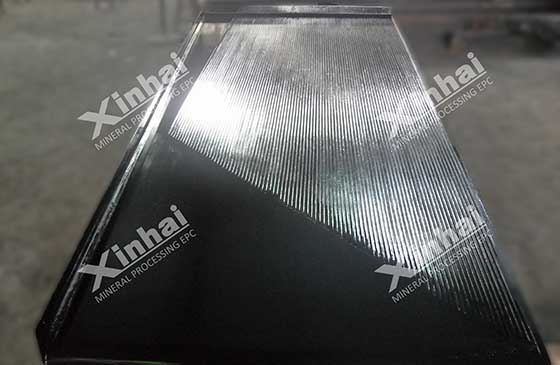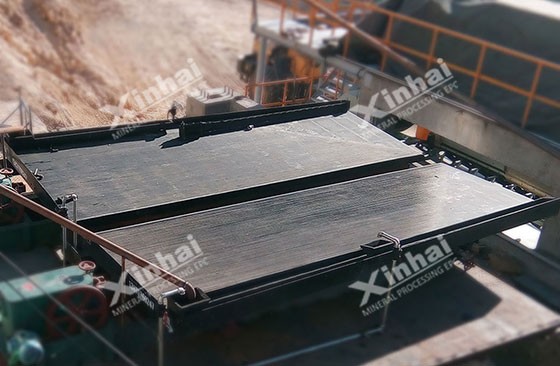

Warm Tip: If you want to know more details about equipment, solutions, etc, please click the button below for free consultation, or leave your requirements!
The beneficiation shaking table can make the ore particles move in different directions according to their density and particle size, and fan out along the diagonal from the feeding trough, and then discharge along the edge of the shaking table surface in turn. The discharge line is very long and can accurately produce a variety of products with different qualities, such as concentrates, secondary concentrates, middling concentrates and tailings.
There are many influencing factors in the process of shaking table ore beneficiation, but the influence of the main technological factors on the beneficiation can be summarized as the following 5 main problems:

It has a great influence on the selective transport of ore particles along the longitudinal direction and the loosening of the particle layers on the table.
Appropriate asymmetry requires not only to ensure good selective transport performance, but also to ensure that the particle layers on the table is sufficiently loose.
For coarse-grained materials that are difficult to loose and easy to transport, the asymmetry should be smaller; for fine-grained materials that are easier to loose but are more difficult to move, the asymmetry should be greater.
They directly determine the speed and acceleration of the shaking table surface movement. Therefore, it also has a great influence on the loose layering and selective transportation of the shaking table.
The best length and times of stroke should make the shaking table chromatographic separation layer good and the selective transport ability strong.
For coarse-grained materials, concentrating operations and large loads situation, we should use large stroke length and small stroke time. Generally, the stroke length is 16-30 mm, and the stroke time is 200-250 times per minute.
For fine-grained materials, roughing operations and small loads situation, we should use small stroke length and large stroke time. Generally, the stroke length is 8-10 mm, and the stroke time is 250-300 times per minute.
Appropriate length and times of strokes are best determined by beneficiation tests or referring to similar processing plants’ experience.
They both affect the lateral water flow velocity on the shaking table surface and the thickness of the water layer, and determine the speed of lateral transport of ore particles and the effectiveness of the cleaning. Therefore, it is a factor that is often adjusted during operation.
Increasing the slope can reduce the amount of water, and vice versa. Increasing the water volume and reducing the slope can make the water layer thicker.
In operation, the water volume and slope must be well matched.
For coarse-grained materials, difficult-to-separate materials and concentrating operations, which require a larger flow velocity and a thicker water layer, we should adopt a small slope and large water volume system;
For fine-grained materials, easy-to- separate materials and roughing operations, which require a larger flow rate and a thinner water layer, we should adopt a large slope and small water volume system.
The inclination angle is generally 0°~10°; the water volume is 20~50 liters/min.
They both affect the layering and transportation speed.
Excessive ore feed volume will make the particle layer too thick, deteriorate the layering, increase the transportation speed, and increase the grade of tailings and decrease the recovery rate. If the feed volume is too small, the processing capacity will be greatly reduced.
If the concentration is too high, sand piles will appear; if the concentration is too small, furrow may occur on the layer.
The feed volume and concentration should be well matched. The principle is to select the best feed concentration within the allowable feed volume load range.
Generally, the ore concentration is 15-25%, the high value is used for coarse particles, and the low value is used for fine particles. When dealing with placer ore larger than 0.2 mm, the production capacity is 0.7~2.3 tons/unit; when dealing with fine-grained materials smaller than 0.2 mm, the production capacity is 0.2~0.5 tons/unit.
They affect the accuracy of separating by density.
For this reason, classifying, desliming and coarse removing before selection are necessary.
The round shape ore particles which are too coarse and heavy not only interfere the separation of fine particles, but also easily to be lost in the tailings. But if the thick and round ones are gangues, it is good for separation.
The fine sludge is not easy to settle, and it is easy to lose in the tailings.
After classifying, ore particles would have uniform particle size and easy to operate and adjust. Then we can use reasonable load distribution of the coarse and fine shaking tables to improve the production capacity.

The above are the 5 factors that affect the process of shaking table beneficiation. In actual production, you can refer to the above factors and choose the most suitable parameters according to your own ore situation to get the best beneficiation effect.
If you're interested in the maintenance of shaking table, we also have an article about it.
If you have any questions about the content of this article, or want to buy a shaking table, please contact the online customer service to communicate, or leave a message on the website, we will talk to you in detail as soon as possible.
Last: 4 Types of Rock Drill
15 Gravity Separation Processes You Need to Know
 12
12
 8850
8850


What Are the Differences Between CIP and CIL?
 11503
11503
 0
0